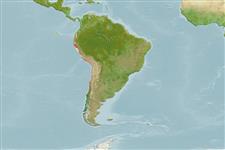| Native range | All suitable habitat | Point map | Year 2100 |

|
| This map was computer-generated and has not yet been reviewed. |
| Sarda chiliensis AquaMaps Data sources: GBIF OBIS |
Issue
Issue on validity of subspecies: subspecies considered as valid in FB, elevated to species rank as Sarda chiliensis (Cuvier, 1832) in Eschmeyer (CofF ver. May 2011: Ref. 86870).
Length at first maturity
Lm 47.0 range ? - ? cm
Human uses
Fisheries: highly commercial; gamefish: yes
Phylogenetic diversity index
(Ref. 82805)
PD50 = 0.5312 many relatives (e.g. carps) 0.5 - 2.0 few relatives (e.g. lungfishes)
Trophic Level
(Ref. 69278)
4.5 ±0.3 se; Based on diet studies.
Resilience
(Ref. 69278)
Medium, minimum population doubling time 1.4 - 4.4 years (K=0.15; tm=2)